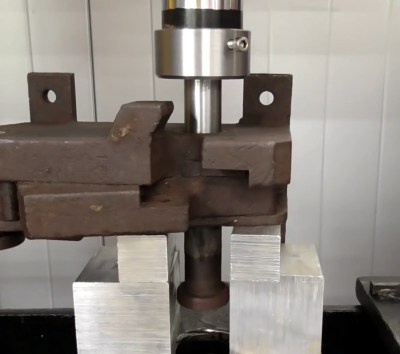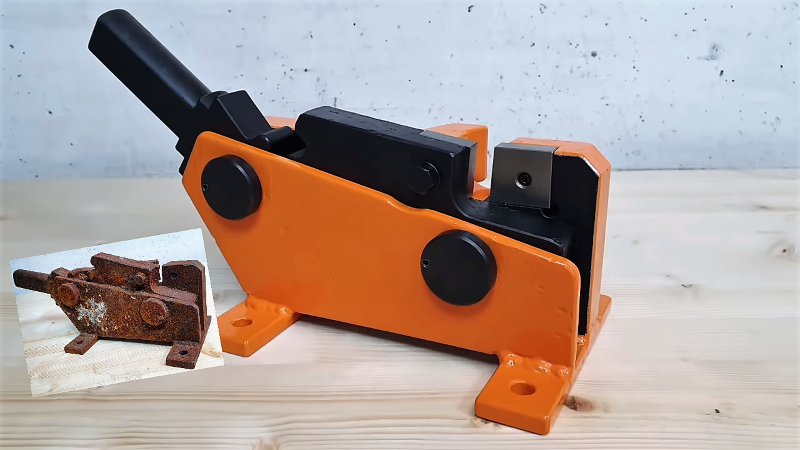We’ve all probably come across hunks of junk that used to be tools, long-neglected and chemically welded into a useless mass of solid rust. Such items are available for a pittance at the local flea market, or more likely found in an old barn or rotting on a junk pile. They appear to be far beyond salvage, but with the proper application of elbow grease and penetrating lubricants, even a nasty old seized-up rebar cutter can live again.
We honestly almost passed up on the video below when it came across our feed. After all, a rebar cutter is a dead-simple device, and half the fun of restoration videos like those made by [my mechanics] is seeing all the parts removed, restored, and replaced. But it ended up being far more interesting than we expected, and far more challenging too.
 The cutter was missing its original handle and looked for all the world like it had been cast from a solid piece of iron oxide. [my mechanics] was able to get the main pivot bolts free with a combination of leverage, liberal application of penetrating oil, drilling, and the gentle persuasion of a hydraulic press.
The cutter was missing its original handle and looked for all the world like it had been cast from a solid piece of iron oxide. [my mechanics] was able to get the main pivot bolts free with a combination of leverage, liberal application of penetrating oil, drilling, and the gentle persuasion of a hydraulic press.
These efforts proved destructive to both bolts, so new ones were made on the lathe, as were a number of other parts beyond saving. New cutters were fabricated from tool steel and a new handle was built; before anyone comments on anyone’s welding skills, please read [Jenny]’s recent article on the subject.
The finished product is strikingly dissimilar to the starting lump of oxidized junk, so there’s going to to be some debate in calling this a “restoration” in the classical sense. The end result of a [my mechanics] video is invariably a tool or piece of gear that looks far better than it did the day it was made, and any one of them would get a place of honor on our shelf. That said, he’d probably be swiftly shown the door if he worked at the Smithsonian.
Whatever you want to call these sort of videos, there are tons of them out there. We’ve featured a few examples of the genre, from the loving rehabilitation of classic Matchbox cars to rebuilding an antique saw set. They’re enough to make us start trolling garage sales. Or scrap yards.
















I have used similar cutters, re-bar is tough stuff, the handle was very long, it needed to be to get leverage, it also needed to be well secured to a strong floor.
It’s so much easier just to cut rebar with a well-aimed Karate chop like This Old Tony does.
Chuck Norris cut rebar with a round-house kick. If it’s good enough for Chuck Norris….
great, there’s about a trillion youtube channels that do the exact same formula of tool “restoration” video’s, can’t wat to see them all here as quota fillers at the end of the week /s
Indeed.
On the one hand, it does seem like “follow recipe, ???, profit!” but I guess it does end up saving tools from the scrap pile!
“does end up saving tools from the scrap pile!”
That’s what I was thinking.
Would be interesting to see a good detail on electropolishing (fast with a battery charger and phosphoric acid) and the electrolysis methods to clean up. I’ve been wondering about where most throw away the stock carburetors and buy new, if worth restoring via electropolishing and then maybe also electroplating so won’t corrode much.
Also, machining new parts that are stainless steel instead of the cheaper brass.
“electrolysis methods to clean up”
If he’d gone that route he likely wouldn’t have had to press out the pins and damage them.
I’ve found electrolysis does a wonderful job of getting right into the cracks and will loosen up press fit parts and indeed threaded fasteners which would otherwise just snap if you tried to undo them first without electrolysis.
Well, if you’re looking for something special take a look at kiwami_japan:
https://www.youtube.com/channel/UCg3qsVzHeUt5_cPpcRtoaJQ
Indeed, but [my mechanics] is two levels above the 99% of the restoration channels; his resorations are simply perfect.
I 100% agree with this. He turns mass production stuff into one-off museum pieces.
Not as much real ‘restoration’ as they often become nicer than the original, but he has amazing techniques, great quality and very chill videos.
Amazing ! Well done.
What is he “painting” the parts with in the end?
A “cold bluing” agent. See https://en.wikipedia.org/wiki/Bluing_(steel)
Haven’t watched it all yet, but it’s interesting that work on the first 3 or so bolts shows the mating parts bone-dry inside – the penetrating oil doesn’t penetrate meaningfully. A number of videos out there from Ave and others say the same thing. With what that stuff often costs…the hammer still reigns it would appear, an no VOCs to imbibe.
The only thing those oils seem to help with in my shop is unscrewing the thing once it’s broken free. Sometimes.
Vegetable oil plus 5% to 50% aceton. Cheap and does the job.